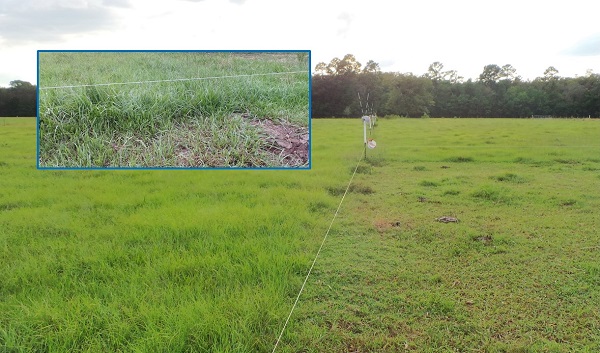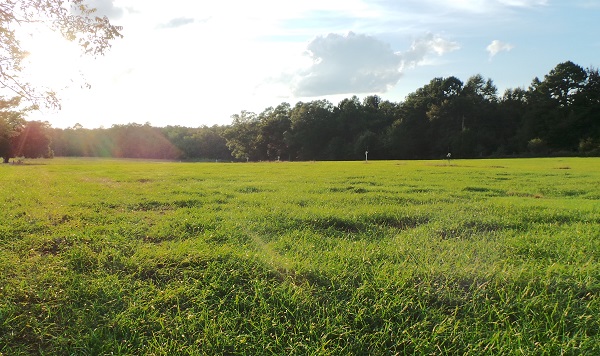
Washington County cow in mid-September with plenty of forage waiting on her just beyond the temporary fence. Photo Credit: Mark Mauldin
There has been a delightful coolness in the air these first few “post Irma” days. Don’t be fooled, it’s not fall yet. Mid-September, in Florida, is definitely still summer and pasture grass should not be in short supply in the summer. This is a good time of year to evaluate your operation’s forage production ability.
Granted we may be a little past our peak forage production, but we are still quite a way from the “fall forage gap” – that rough period when our summer grasses are done and our cool season annuals have yet to really get started. In other words, there should be plenty of forage available right now. If that is not the case on your operation, your “fall forage gap” is going to be much longer than it should be.
There are many factors that can, collectively or independently, result in less than impressive forage production. The purpose of the following comments are to help you identify the factor(s) that might be holding back your forage production. Sitting here at my desk, I won’t presume to tell you you’ve done something wrong with your pastures. I am keenly aware of the old adage: If it don’t rain, it don’t matter. That said, if drought is not the issue at hand, consider that one or more of the following issues may be causing your less than optimum forage production. Each of the issues mentioned below would warrant their own article for a full explanation; the purpose here is simply to introduce the topics and encourage you to honestly evaluate your current situation.
- Weeds – The presence of weeds reduce your pasture’s ability to produce forage. Weeds are undesirable plants that are not readily utilized by livestock, and in some cases are toxic. If these undesirable plants become established in your pasture they can displace desirable forage species, essentially decreasing your acres of grazable forage. We commonly only think of weeds as broadleaf species like Tropical Soda Apple, but some of the most problematic weeds we encounter in Florida are weedy grasses, like smutgrass. Broadleaf or grass, anything that is taking up stealing water and nutrients in your pasture, that your livestock do not utilize is lessening your overall ability to produce forage, and placing added pressure on the remaining desirable forage. Take steps to identify weeds and begin a control program. Weed Management in Pastures and Rangelands will be a valuable tool in this effort.
- The Wrong Grass – Unfortunately, I have received more than one call about “bahiagrass” that won’t grow. More often than not, especially in the northern half of the state, what the producer actually has in their pasture is centipede grass. Centipede is a good turf grass for the same reason it is a horrible forage grass; it doesn’t produce very much no matter what you do to it. Centipede is different from many other weedy grasses, in that livestock will graze it. However, its forage yields are far too low for it to be a viable forage. Centipede “creeps” into pastures and often goes unnoticed until the infestation is quite substantial. If you have areas in your pastures that are green but appear not to grow, take the time to check and see if you have an infestation of centipede grass.
- Soil Fertility – Our improved forage species are bred to be highly productive. However, to reach their potential they must have adequate fertility available all throughout the growing season. Expecting a forge to be highly productive without adequate fertility is akin to expecting an engine to produce maximum horsepower with a clogged fuel line. There may be some level of performance, but the true potential will not be realized. Fertilizing once a year is not sufficient to maximize forage potential. Even if large amounts of nutrients are applied in a single application (which is not advisable) the nutrient demands of the grass will not be met for the entire growing season. Nutrients, like Nitrogen and Potassium, do not remain available to the grass indefinitely. Some nutrients are taken up by plant roots, then grazed and converted into animal tissue or waste; while other nutrients are washed down through sandy soils by frequent rains until they are too deep to be accessed by plant roots. Either way, nutrients need to be replenished to maintain a productive pasture. Utilize a fertility program that is based on a soil test to help maximize forage production. See Fertilizing and Liming Forage Crops for more information on soil fertility management.
- Grazing Management – A key concept to remember here is that, in general, the growth rate of forages increases as the amount of leaf area increases. In other words, as the plant gets bigger it can grow faster. When pastures remain closely grazed, their growth potential is suppressed due to insufficient leaf area. Implementing grazing strategies that allow your pastures to rest for 14-21 days between grazing periods will enable your grass to take full advantage of its rapid growth potential. Not to mention the improvement you’ll see in forage utilization. If you are not currently utilizing any form of rotational grazing, making the switch can be a little daunting, but the long-term benefits will be well worth the initial effort.
While rotational grazing can help improve forage availability, it cannot make up for an excessive stocking rate. As the number of animal units increases, at some point their nutritional demand will exceed what the forage is capable of producing, regardless of management strategies. If you have addressed all of the previously mentioned issues and your forage supply is low before fall arrives, it is highly likely that you have too many cows.
Overstocking/overgrazing can lead to centipede infestations and other weed problems, which compound the forage suppression that is caused by persistent lack of leaf area. Overgrazing can cause a rapid downward spiral in the overall health and performance of a pasture. Grazing Management Concepts and Practices provides more specific recommendations for improving your grazing management.

Main Image: The edge of a grazing cell (or paddock), used in an intensive rotational grazing system in Washington County. Inset: A closer view at the amount of forage awaiting the herd in the next cell. Both pictures taken 9/14/17. Photo Credit: Mark Mauldin
The list of issues above is by no means exhaustive. There are other factors that reduce forage productivity but in my experience the ones listed are the most frequent offenders. It is my hope that you read this without concern because your cows are fat as ticks, standing in belly deep grass. If that is not the case, contact your county’s UF/IFAS Agricultural Extension Agent for assistance identifying and fixing whatever the issue is that is limiting your forage production.

A “bonus” hayfield; acreage cut for hay in late July to more efficiently utilize excess mid-summer forage. Regrowth is being stockpiled and will be used to help bridge the fall forage gap. Picture taken 9/14/17. Photo Credit: Mark Mauldin
- Improve Your Pasture Management this Spring - April 19, 2024
- Plant Now for the Panhandle Watermelon Festival Big Melon Contest & New Junior Jubilee Kid’s Contest - March 8, 2024
- Central Panhandle Pesticide Applicator Training Series – February 12-15 - January 19, 2024
